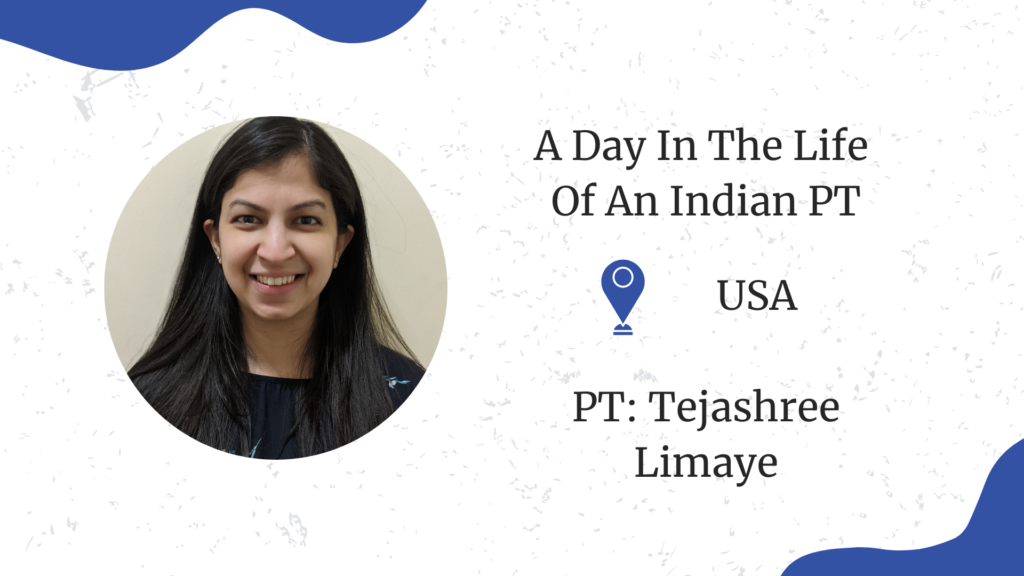
Hey there! I am Tejashree, Founder of PT Career Paths. As some of you may already know I also work as an outpatient physical therapist in the USA. After completing a Master’s in musculoskeletal physiotherapy from India, I moved to the USA. I have about 9 years of work experience, 4 years in India, and 5 years in the USA. I have been repeatedly asked about PT work culture in the USA, similarities, and differences in the healthcare system, and what my workday looks like. This article goes over a day in the life of an Indian physiotherapist in the USA.
Please note that this is the experience of just one Indian PT in the USA. This may or may not reflect the picture true for all.
What are your timings, Do you work on weekends?
Timings vary depending on the day. For example, when I worked full-time, my clinical hours used to be as follows:
- Monday and Wednesday 7 am to 3 pm
- Tuesday and Thursday 10 am to 7 pm
- Friday 8 am to 4 pm
These were my clinical hours, meaning, I used to treat patients during these times. Additionally, I spent an average of 1 hour daily finishing my notes plus 1 hour of travel time.
So far, I never had to work on weekends.
How are appointments scheduled?
Appointments are for an hour, some facilities have 45 minutes time slots.
New evaluations are scheduled one on one. While for follow-ups, 2 patients are scheduled at the same hour. Meaning, I see 2 patients simultaneously for 1 hour.
I also see patients on one on one basis if the patient needs more individualized attention. For example, if the patient is at risk of falls.
What is the avg no of patients you see in a Day?
On average I see 10-12 patients/per day
Can you give us details about patient management in the USA
Each patient gets an initial evaluation by a physical therapist when they visit for the first time. The evaluation note has 4 components: Subjective, Objective, Assessment, and Plan.
Subjective: Patient’s chief complaints, mechanism of injury, medical and surgical history. One of the key factors that I include in my notes is the patient’s prior level of function and the patient’s current level of function. For example, the Patient used to play tennis for 2 hours, 3 times a week prior to hurting his knee. Currently, the patient is unable to play tennis due to knee pain.
Objective: This section includes measurements you take at the time of evaluation. Observations, palpation, ROM, MMT, special tests, and functional tests are all documented in this section
Assessment: This section includes a summary of your objective findings and how the impairments are affecting the patient’s daily function. I also write why the patient needs skilled physical therapy treatment. I also jot down patients’ goals and approximate timelines to achieve those goals.
Plan: Here I document the duration and frequency of PT visits for the patient (for example, Twice a week for 6 weeks). I also list various treatments I plan to do such as therapeutic exercises, balance training, manual therapy, etc.
Outcome measure: Patients also complete a functional outcome questionnaire at the first visit. Depending on the condition patient will fill out Quick DASH, NDI, ODI, LEFS, etc.
Diagnosis codes, and treatment codes: As a PT, I need to include ICD 10 diagnosis codes and treatment codes with each note when submitting the paperwork. PTs get training about different codes and guidelines before they start working.
Daily notes: As I start seeing patients on a regular basis, I complete daily notes for each of the following visits. Daily note also contains all of the sections mentioned above. I update each section every visit. I also keep a record of exercises, and manual treatments performed in that session. At the end of each daily note, I make a comment about the patient’s progress.
Progress notes: We complete progress notes every 4 weeks. At the time of the progress note, we reassess all the objective measures. We monitor the patient’s progress toward his/ her goals and update the plan of care as needed. Patients also complete functional outcome measures again (Quick DASH, NDI, ODI, LEFS).
Any comments if the similarities and differences between working in India and Vs USA
Differences:
- I need to do extensive documentation as compared to what I did in India.
- ICD-10 treatment and diagnosis codes are used with each note.
- I rarely used electrotherapy modalities in the USA. Hot packs and cold packs are commonly used modalities. I worked in 4 different outpatient clinics in the USA and none of the clinics had SWD!
- Patients usually show up on time, often 5-10 minutes before their scheduled appointment.
Similarities:
- Management of the different conditions is pretty similar except for the use of electrotherapy.
- When I first started working in the US, I was a little anxious since I was going to be working in a totally different country that has totally different language and culture. As soon as I started working, I realized that we are not that different after all. The patients I was treating every day had similar bodily dysfunctions, similar emotional experiences, and similar psychological makeup as patients back in India. We are all humans! And that is who we are treating every day, humans! Not just herniated discs and sprained ankles!
Challenges you faced as an Indian PT in the USA.
Working as a PT in the USA did come up with its own set of challenges! Credentialing and licensing process in itself involves a lot of steps and can feel confusing and overwhelming. You can read about my experience of getting licensed in the USA on an h4 visa in this article.
When first starting out, I needed to learn in detail about how the documentation should be. Depending on the day, documentation can feel overwhelming sometimes. Keeping up with documentation when doing treatments might not always be possible. I need time to finish up my notes at the end of my workday
Long hours and workload can lead to burnout. I know I experienced it in the past. Excessive workload and work hours left no room for work-life balance. That was one of the reasons why I left full-time work and transitioned to part-time work. Although common, not all PTs experience burnout.
What do you like/ enjoy about your work as an Indian Pt in the USA?
I get to learn from colleagues, patients, and educational opportunities presented by my employer. In the USA, each PT has to take professional education courses typically every 2 years. This is to fulfill the continuing education credit requirement to renew the license.
Most companies offer structured career growth. It is currently not applicable to me since I work part-time. But many full-time employees get opportunities for various leadership positions.
So there you have it, a day in the life of an orthopedic outpatient PT in the USA. If you are planning to transition to USA and have questions about the process, get on the waitlist to schedule one on one consultations.

Hello, My name is Tejashree Limaye. I am a physiotherapist with 10+ years of experience. I help you go from being stuck in your career to finding a job you love! I provide career guidance about clinical and non clinical PT career in India. I also help you with US PT licensing process. Welcome to my blog, I hope you find the exact guidance you have been looking for!
